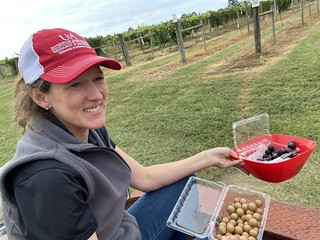Conference brings muscadine, bunch-grape researchers to Arkansas on Oct. 3-5
Muscadines, with their distinct flavor and thick skins, have 20 chromosomes, one more than bunch grapes. However, researchers see benefits in creating a hybrid of the two.
By Mary Hightower
U of A System Division of Agriculture
Sept. 22, 2023
Fast facts
- Conference set for Don Tyson Center in Fayetteville
- Event includes research presentations
- Agenda includes discussions of economics, breeding, marketing, production
(450 words)
(With art of Threlfall, Worthington)
FAYETTEVILLE, Ark. — Muscadine and bunch-grape growers and researchers have tended to move in their own circles. Until now.
The University of Arkansas System Division of Agriculture will host the North American Grape Breeders and Vitis-Muscadine Alliance Conference on Oct. 3-5 at the Don Tyson Center for Agricultural Science, 1371 W. Altheimer Drive, in Fayetteville.
“To my knowledge, the conference is one of the first national attempts at a collaboration of people working with Vitis and Muscadinia,” said Renee Threlfall, a research scientist, enology and viticulture for the division’s Arkansas Agricultural Experiment Station, and director of the Arkansas Quality Wine program. “Muscadines are very ‘regional’ so many U.S. consumers have never heard of them, never mind having tasted a muscadine grape or a product made from muscadines.”
“Vitis” is the genus that encompasses all grapes, whether they’re grown for food or wine. Bunch grapes — which include those used for wines, raisins and eating fresh — and muscadines, each belong to a separate subgenus. And that’s where things get interesting.
Muscadines, with their distinct flavor and thick skins, have 20 chromosomes, one more than bunch grapes. However, researchers see benefits in creating a hybrid of the two. That decades-long quest is driven by several factors such as being able to lend some of the muscadine’s disease resistance to the table grapes.
“Breeding efforts between these genera have already begun, resulting in new grape cultivars, some with attributes like Vitis, some like Muscadinia, but also many with attributes of both,” Worthington said. “This project is important because we believe there is much more to be gained in future collaborations, bringing the best of two powerhouse grape species together.”
The conference is the culmination of work conducted under a Specialty Crop Research Initiative grant from the U.S. Department of Agriculture’s National Institute of Food and Agriculture, or NIFA. Threlfall and Margaret Worthington, associate professor and fruit breeder for the University of Arkansas System Division of Agriculture, obtained the grant in 2022.
The event is comprised of the North American Grape Breeders Meeting on Oct. 3. The following day includes a tour of the Division of Agriculture’s research vineyards and wineries. Oct. 5 is the Vitus-Muscadina Alliance Conference.
The conference will include discussions of breeding, production, marketing and economics. Threlfall also said the results of a survey on consumer preferences for fresh-market grapes will be revealed at the conference.
“We conducted an online survey of more than 900 consumers from all U.S. regions, asking their preferences for fresh-market grape options,” Threlfall said. “These preferences will be used to inform future breeding efforts.”
Attendance is by invitation. For more information, contact Renee Threlfall at rthrelf@uark.edu.
Learn about the Division of Agriculture’s grape-breeding program.
To learn about extension programs in Arkansas, contact your local Cooperative Extension Service agent or visit www.uaex.uada.edu. Follow us on Twitter and Instagram at @AR_Extension. To learn more about Division of Agriculture research, visit the Arkansas Agricultural Experiment Station website: https://aaes.uada.edu/. Follow us on Twitter at @ArkAgResearch. To learn more about the Division of Agriculture, visit https://uada.edu/. Follow us on Twitter at @AgInArk.
About the Division of Agriculture
The University of Arkansas System Division of Agriculture’s mission is to strengthen agriculture, communities, and families by connecting trusted research to the adoption of best practices. The Division of Agriculture conducts research and extension work within the nation’s historic land grant education system through the Agricultural Experiment Station and the Cooperative Extension Service.
The Division of Agriculture is one of 20 entities within the University of Arkansas System. It has offices in all 75 counties in Arkansas and faculty on five system campuses.
The University of Arkansas System Division of Agriculture offers all its Extension and Research programs to all eligible persons without regard to race, color, sex, gender identity, sexual orientation, national origin, religion, age, disability, marital or veteran status, genetic information, or any other legally protected status, and is an Affirmative Action/Equal Opportunity Employer.
# # #
